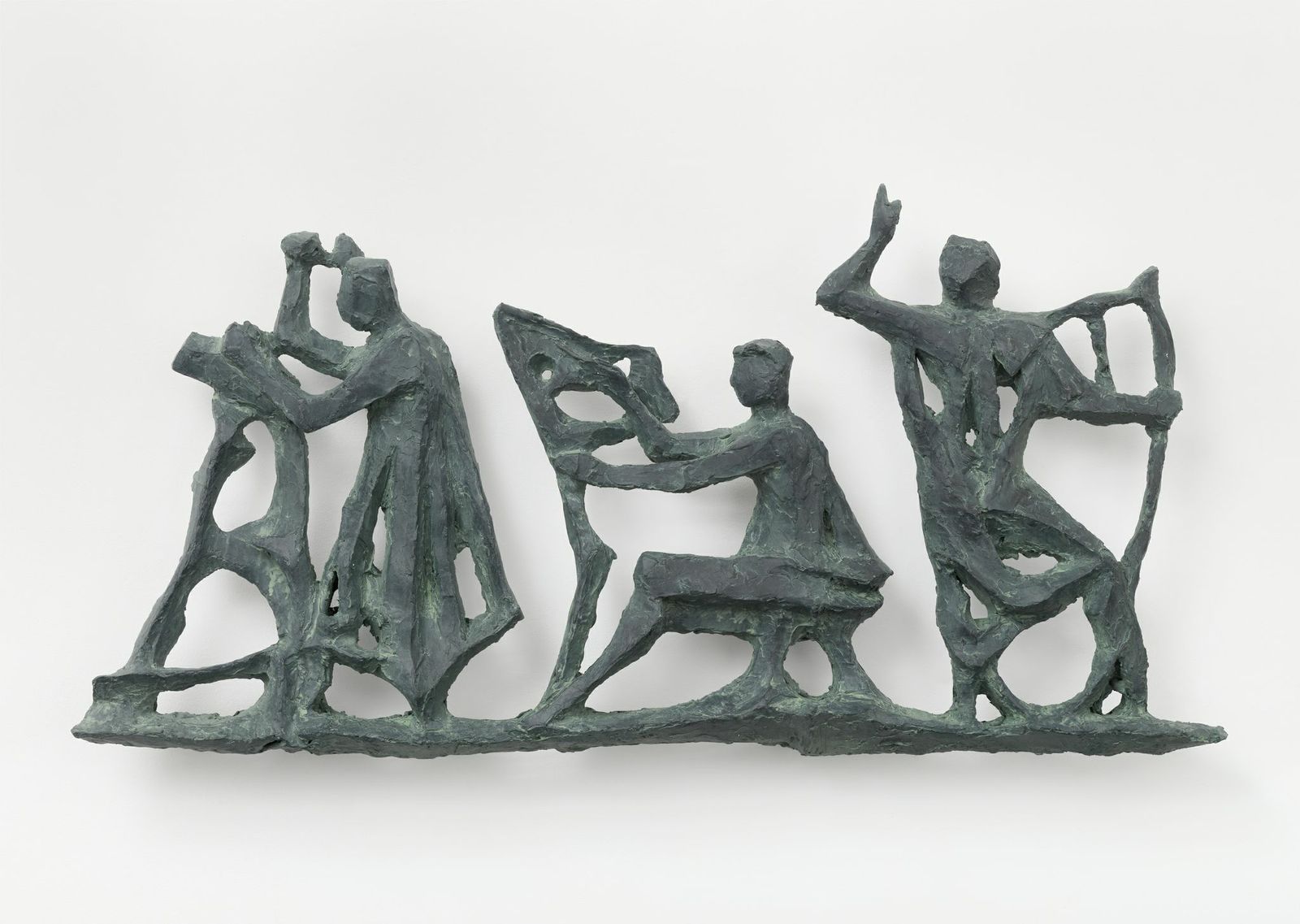Swiss put sculpture centre stage at Biennale

The 2013 Venice Biennale, entitled “The Encyclopaedic Palace” after an imaginary museum housing all worldly knowledge, has some unique Swiss visions on display in the shape of Carl Jung’s “Red Book” and work by up and coming Valais artist Valentin Carron.
The 36-year-old artist has teamed up with curator Giovanni Carmine, director of the Kunst Halle Sankt Gallen museum, to showcase his work against the modernist architecture of the Swiss Pavilion, designed in 1952 by Bruno Giacometti.
Entering Carron’s exhibition we immediately come face to face with an 80-metre-long two-headed, cast-iron snake. While one head looks out over the top of the exterior wall of the pavilion, the other guards the main door. Each one is joined by a long thin body that winds its way through the building introducing the visitor to Carron’s paintings and sculptures.
The metal snake neatly sums up Carron’s artistic approach: the journey is much more important than the final destination.
“The snake was just an excuse, used in the building in a way that respects the space. It’s a great excuse to create a fantastic line. I wasn’t looking to give the snake any special symbology as it already has plenty associated with it,” the artist told swissinfo.ch.
The reptile leads us to 17 different works as it snakes around each room changing in volume. As it climbs one wall decked in Italian cloth, it transforms into a thin delicate line.

More
Inside the Swiss Pavilion
Poetic rigour
But the journey was not always a simple one. Restless and curious, Carron’s life is one of constant change.
“We started nine months ago with the plan of the pavilion. Every week I had new ideas, new concepts and new solutions. I changed lots of things right up until the curator and I decided on a final project. Work started on the individual pieces at the end of last year,” explained Carron.
For Carmine, Carron’s work plunges deep into the meaning of art and adds a unique filter – that of his place of origin, canton Valais.
“The process was very creative and intense. We combined our efforts in a very precise and efficient way. He’s an artist who manages to stamp his own poetic mark even with his formal rigour,” said the curator.
The idea for the snake comes from a detail found on a window on a Zurich fire station building. Its elegant and minimalist shape respects the pavilion’s art nouveau style, but Carron gave it a new interpretation.
“For me each and every art movement of the 20th century is important. I focus on different periods. My interest changes all the time. It’s like a TV and I’m switching channels all the time. For these pieces here, these two sculptures of instruments [flattened musical instruments cast in bronze], I was on Channel 60, from the 1960s, the neorealism channel.”
This allusion to neorealism partly explains the presence of a 1967 Piaggio moped in the middle of the pavilion courtyard which Carron carefully restored without being 100 per cent faithful to the original. His restoration work raised questions about adolescent desires, speed limits and even the correct tone of paint to use.
The 55th Venice Biennale International Art Exhibition, the world’s oldest contemporary art fair, runs from June 1 to November 24, 2013 and features 158 artists from 88 countries. Switzerland is represented by Valentin Carron, who was born in 1977 in Martigny, Switzerland.
Carron studied the Ecole Cantonale des Beaux-Arts in Sion, Switzerland and at the Ecole cantonale d’art de Lausanne (Ecal). He has held exhibitions throughout the world including at the Palais De Tokyo, Paris; La Conservera, Murcia, Spain; L’elac, Renens, Switzerland; Viafarini, Milan; Praz-Delavallade, Paris; Swiss Institute, New York; and Kunsthalle Zurich.
The Swiss Biennale pavilion was curated by Giovanni Carmine, director of the Kunst Halle Sankt Gallen.
The title chosen by curator Massimiliano Gioni for this year’s Biennale is “Il Palazzo Enciclopedico” or “The Encyclopaedic Palace”. It is taken from the title of a symbol of 1950s-era Futurism — a three metre tall architectural model of a 136-storey cylindrical skyscraper that was intended to house all the knowledge in the world. Its creator, the self-taught Italian-American artist Marino Auriti, dreamed it would be built on the National Mall in Washington.
“The Red Book” by Carl Gustav Jung — the father of analytical psychology – is displayed in a round glass case in the center of the rotunda in the biennale’s main pavilion. Jung’s elaborately illustrated manuscript, made over 16 years, catalogues his visions.
Reinterpretation
Carron’s innovative strength, however, is to go beyond the original source and to give new meaning to established forms. He manages to give them new content and reproduce classic archetypes in his paintings and sculptures.
“He manages to unite different discourses of identity and enhance them without being moralistic. Carron reclaims interesting techniques and aesthetic ideas that have been overlooked or wrongly reinterpreted,” said Carmine.
One example is his series of flattened musical instruments originally made of a copper and zinc alloy that were trampled on, crushed and finally cast in bronze. The technique comes from the French neorealism movement, but the destructive gesture is well and truly a ‘punk’ one. The instruments are exhibited inside and outside the pavilion, camouflaged against the walls, and although they look alike they are not.
He creates similar illusions with six fibreglass and resin paintings. Their surfaces resemble cement and are in perfect harmony with the raw materials used to build the Swiss pavilion. Coloured ‘windows’ drawn on the surfaces mimic the glass windows on the facade of the Royal Academy of Fine Arts in Brussels. Each painting is different and pays tribute to modernist abstract work.
“I don’t have a favourite material to work with,” explained Carron. “Each material offers me the possibility of meeting new people and using new techniques to get new results.”
His aim is to produce work that respect architecture without any pretention of attempting to transmit a specific message. “That’s the job of politicians and philosophers,” he said with a hint of irony.
(Adapted from Portuguese by Simon Bradley)

In compliance with the JTI standards
More: SWI swissinfo.ch certified by the Journalism Trust Initiative
You can find an overview of ongoing debates with our journalists here. Please join us!
If you want to start a conversation about a topic raised in this article or want to report factual errors, email us at english@swissinfo.ch.